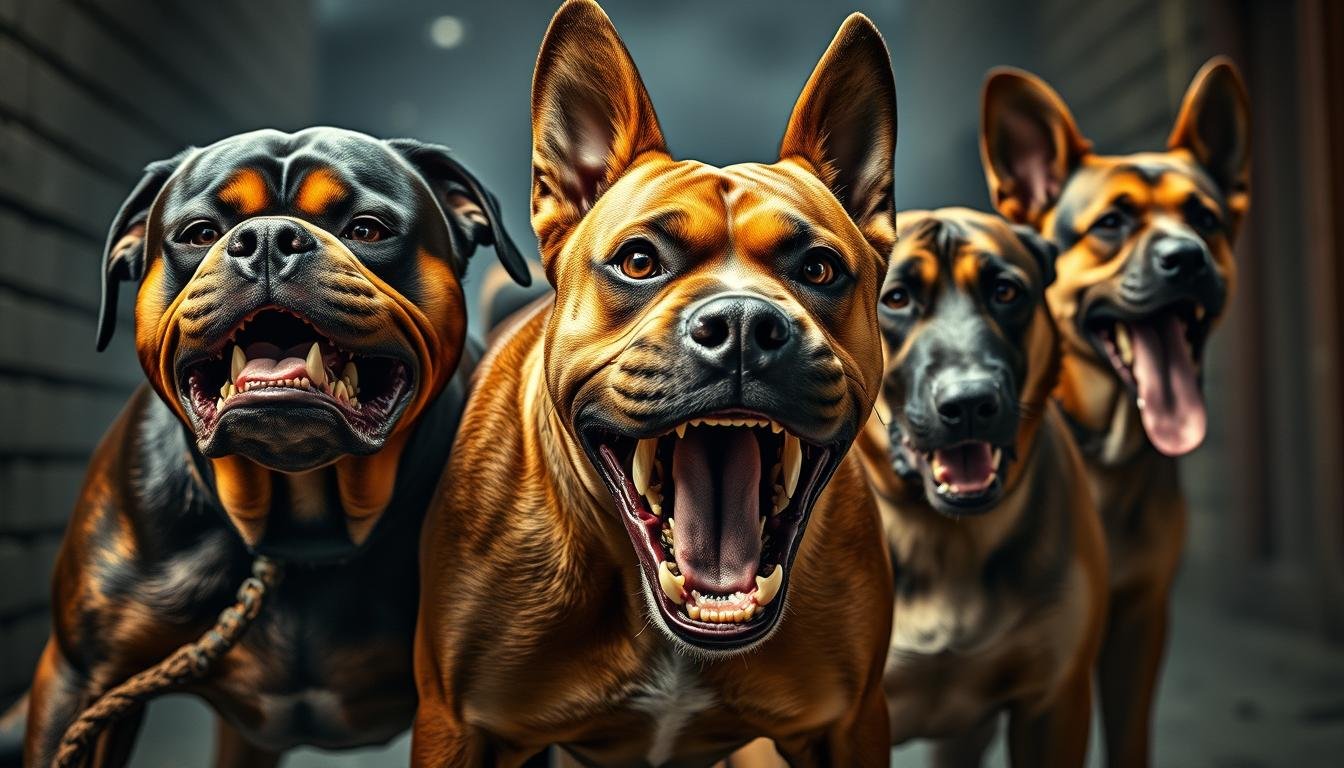Dangerous Dog Breeds in 2025: What You Need to Know
If you’re thinking about getting a dog or often meet dogs, it’s vital to know some breeds are seen as more aggressive. This is because of their size, strength, and how they act.
Some breeds are linked to a higher chance of attacks. Knowing this helps you make smart choices for your family.

Learning about these breeds’ traits helps you handle situations better. It also guides you in deciding if a new pet is right for your home.
Table of Contents
Understanding Canine Aggression
Canine aggression comes from many sources, both inside and outside the dog. To tackle this problem, we need to explore the root causes.
Nature vs. Nurture in Dog Behavior
The debate on nature versus nurture in dog behavior is still going on. Studies show that both genetics and environment play a part in aggression. Even though some breeds might be more aggressive due to their genes, how a dog is raised matters a lot.
Factors That Influence Aggressive Tendencies
Many things can make a dog more aggressive. Knowing these factors is key for dog owners and those around them.
Genetic Predisposition
A dog’s genes can greatly affect its behavior. Some breeds were bred for guarding or fighting, making them more aggressive.
Training and Socialization
Good training and socialization help reduce aggression. Dogs that are well-trained and socialized are less likely to be aggressive.
Environmental Factors
Knowing these factors helps us understand the risks of high-risk canines and menacing breeds. We can then take steps to prevent aggression.
What Makes a Dog Breed Considered “Dangerous”
When we say a dog breed is “dangerous,” we mean it for good reasons. These reasons affect how people see the breed and the risks of owning one.
Bite Statistics and Severity
Dogs that often bite seriously are seen as dangerous. Pit Bulls and Rottweilers are known for their aggressive attacks. They are more likely to cause fatal or severe bites.
Physical Characteristics and Capabilities
A dog’s looks and strength matter a lot. Size, strength, and jaw shape can lead to serious injuries.
Size and Strength
Bigger, stronger dogs are often seen as more dangerous. This includes wolf hybrids and large guard dogs.
Jaw Structure and Bite Force
A dog’s jaw and bite force are key to its danger. Some breeds have a stronger bite, making them more risky.

Historical Breeding Purposes
Breeds made for guarding or fighting, like Doberman Pinschers and German Shepherds, are often seen as dangerous. This is because of their history and natural traits.
Knowing these points helps you decide if a dog is right for you and your safety.
Most Common Dangerous Dog Breeds in the United States
Knowing the most dangerous dog breeds is key for safety. Some breeds are linked to severe attacks. Knowing their traits helps you stay safe around them.
Pit Bull Terriers
Pit Bull Terriers are often seen as dangerous. This is because of their strength and past use.
Physical Traits and Temperament
Pit Bulls have strong muscles and jaws. Yet, they can be loving and friendly if trained right.
Attack Statistics
Studies show Pit Bulls cause many fatal dog attacks. Knowing their aggression helps prevent attacks.

Rottweilers
Rottweilers are known for guarding and strength. They can be dangerous if not handled right.
Guarding Instincts
Rottweilers guard their territory and loved ones. This can be seen as aggression.
Potential Risks
Rottweilers can hurt badly because of their size and strength. Training and socializing them is key to safety.
German Shepherds
German Shepherds are smart and versatile. They’re used in police and military work. But, their energy and protectiveness can lead to aggression.
Working Dog Background
German Shepherds were bred for herding. They’re loyal and protective. This makes them great pets but also potentially dangerous if not handled correctly.
Aggression Triggers
German Shepherds can be aggressive if they feel threatened or not socialized. Knowing what triggers their aggression is important for owners.
Doberman Pinschers
Doberman Pinschers are loyal and athletic. They can be great pets but need careful handling because of their guarding nature.
Wolf Hybrids
Wolf Hybrids mix domestic dogs with wolves. They can act unpredictably because of their wild heritage. Their strength and aggression make them risky for inexperienced owners.
Other High-Risk Breeds
Breeds like Akitas, Chows, and Cane Corsos are also risky. They’re big, strong, and protective, needing careful handling.
Akitas
Akitas are loyal and protective of their families. But, their size and strength mean they can be dangerous if not trained right.
Chows
Chows can be aloof and protective. They need careful socialization to manage their aggression.
Cane Corsos
Cane Corsos are big and muscular, bred for guarding. Their size and protective nature require experienced handling.
The dangerous breeds share traits like strength, guarding instincts, and aggression if not managed. Knowing these traits helps you make safe choices around them.
Breed-Specific Legislation and Restrictions
Breed-specific laws are key for dog owners, affecting many breeds seen as high-risk. It’s important for owners or those thinking of getting a dog to know the laws. This knowledge helps avoid legal trouble.
State and Local Laws
States and cities have different rules for dog breeds. Some places ban or limit owning dangerous dog breeds like Pit Bulls or Rottweilers. Knowing your area’s laws is crucial to stay out of trouble.
Insurance Implications
Having a high-risk canine can raise your insurance costs. Some insurers might not cover certain breeds or charge more. This is because they see these dogs as riskier.
Housing Restrictions
Some places, like housing complexes or neighborhoods, may not allow certain breeds. Always check any agreements or contracts before getting a dog. This ensures you won’t face unexpected issues.
Warning Signs and Prevention of Dog Attacks
Knowing how menacing breeds act can keep you safe. It’s key to spot the signs of a dog attack early. This helps protect you from harm.
Reading Canine Body Language
Body language tells a lot about a dog’s mood. Signs of aggression include stiff posture, raised hackles, and staring straight at you. If a dog’s ears are back and its tail is tucked, it might be scared or feeling submissive.
Situations That Trigger Aggression
Some situations make dogs aggressive, like feeling threatened or protecting their space. Knowing these can help you stay out of trouble.
How to React During a Potential Attack
If a dog looks like it might attack, stay calm and don’t look at it. Do not run, as it might make the dog chase you. Slowly back away and try to leave without turning your back on the dog.
Responsible Ownership of Dangerous Dog Breeds
When it comes to risky dog breeds, the key to a harmonious coexistence between dog and community lies in responsible ownership. Owning a breed that’s considered dangerous isn’t just about providing a home. It’s about ensuring that your pet doesn’t become a threat to public safety.
Proper Training and Socialization
Proper training and socialization are foundational elements of responsible dog ownership, especially for breeds with a history of aggression. Early intervention is critical in shaping your dog’s behavior.
Early Intervention
Starting training early helps in instilling good behavior and preventing unwanted habits from forming. It’s essential to expose your dog to various environments and people to foster a well-adjusted temperament.
Professional Training Resources
Utilizing professional training resources can provide you with the tools and techniques necessary to manage your dog’s behavior effectively. Consider enrolling your dog in obedience classes or working with a professional dog trainer.
Secure Containment and Public Safety
Ensuring your dog is securely contained and under control when in public is vital for preventing incidents. This involves a combination of appropriate fencing around your property and leash control when out in public.
Appropriate Fencing
A sturdy fence that is high enough to prevent escape is essential for containing your dog. The type of fencing may vary depending on the breed and its capabilities.
Leash Control
When in public, keeping your dog on a leash and under control is crucial. This not only prevents unwanted interactions but also ensures your dog’s safety.
Spaying/Neutering Considerations
Spaying or neutering your dog can have a significant impact on its behavior, potentially reducing aggression. This procedure is often recommended for breeds prone to violent behavior.
| Consideration | Impact on Behavior |
|---|---|
| Spaying/Neutering | Can reduce aggression and undesirable behaviors |
| Proper Training | Helps in developing a well-behaved and adjusted dog |
| Secure Containment | Prevents escape and reduces risk to public safety |
“Responsible dog ownership is not just a moral obligation, it’s a necessity, especially when dealing with breeds that have the potential to be dangerous.”
Conclusion
Owning dogs that are hazardous or fierce requires a deep understanding. You must know their characteristics and risks. This knowledge helps you take steps to reduce threats.
Responsible ownership is key to public safety and the dogs’ well-being. It’s important to train them properly, keep them contained, and consider spaying or neutering. These actions help lower risks and make the environment safer for everyone.
Certain breeds are considered hazardous due to their history, physical traits, and bite statistics. Being aware of these factors and taking responsible steps can help. This way, you can enjoy a positive relationship with your dog.
FAQ
What are considered the most dangerous dog breeds in the United States?
In the United States, the most aggressive dogs include Pit Bull Terriers and Rottweilers. Also, German Shepherds, Doberman Pinschers, and Wolf Hybrids are considered high-risk canines.
What factors contribute to a dog’s aggressive behavior?
A dog’s aggression comes from genetics, environment, and social factors. This includes their breeding history, training, and how they were socialized.
How can I identify warning signs of a potentially aggressive dog?
To spot aggressive behavior, watch for growling, bared teeth, and raised hackles. Understanding canine body language is key.
What are the key elements of responsible ownership for hazardous pups and fierce canines?
Responsible dog ownership means training and socializing them well. It also includes keeping them contained and considering spaying or neutering. This helps reduce the risks of dangerous breeds.
Are there any breed-specific laws or regulations I should be aware of?
Yes, laws about certain dog breeds vary by state and local area. It’s important to know these laws to avoid legal trouble and keep everyone safe.
How can I prevent dog attacks when interacting with risky dog breeds?
To prevent dog attacks, understand their behavior and watch for warning signs. Knowing how to react during an attack is also crucial.
What should I do if I’m confronted by an aggressive dog?
If faced with an aggressive dog, stay calm and avoid eye contact. Slowly back away to de-escalate the situation.

